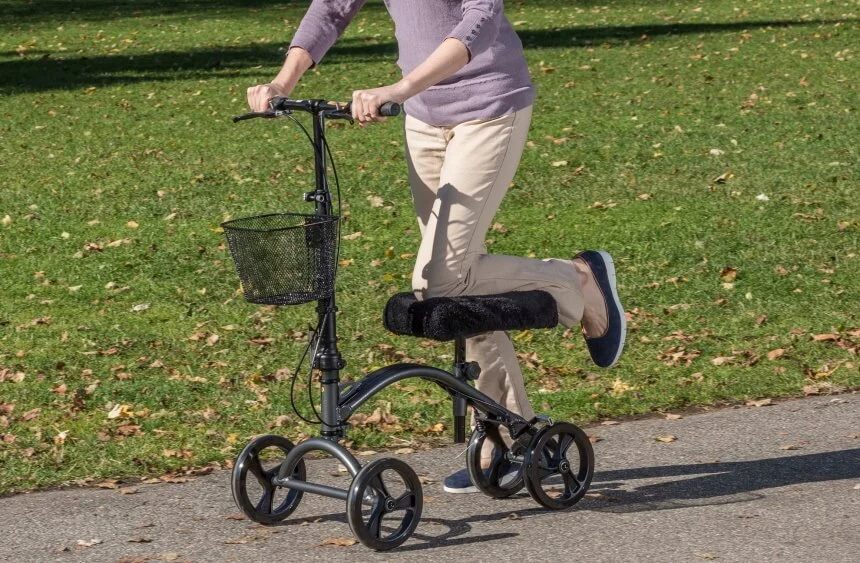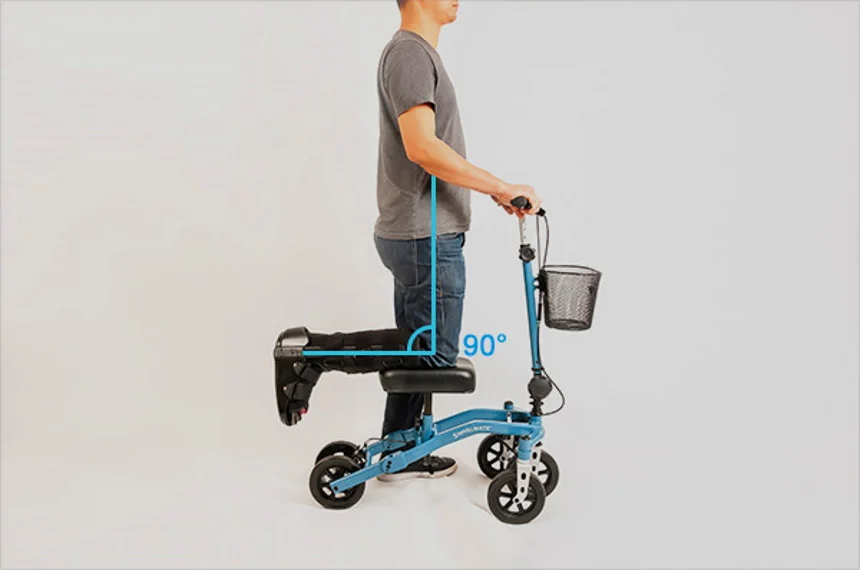
A knee scooter, or a knee walker, is a device designed for the medical recovery of injuries below the knee. They are a more modern alternative to canes, crutches, and traditional walkers. Knee scooters enable free and comfortable movement because, let’s face it, no one likes to sit at home all day.
A question we usually get is: how to use a knee walker? The process is relatively easy to follow. First, put your injured leg on the padded seat, place your hands on the handlebars, and scoot along with the other foot. It isn’t necessary to use your foot as a brake; you can also use the scooter’s brakes. This article will highlight all you need to know about using a knee scooter.
A knee scooter is a non-motorized form of wheeled transportation with three or four wheels. Assume you have a leg injury and need to run a few errands. A knee scooter has handles and a cushioned pad to help you remain comfortable while being mobile. The goal is to maximize mobility while ensuring a safe recovery.
The handlebars control the knee scooter, and the pad protects your injured leg. Stand beside the scooter, grab the handlebars, and gently squeeze the brake to keep the scooter from moving while you position your lag. As shown, your leg should be at 90°. The knee rest can be adjusted. So, adjust it to the desired position by raising or lowering it.
Furthermore, your hips should be level, there should be no hunching, and you should stand erect on the other leg. Keep in mind that the handlebar is also adjustable and should be level with your waist. This is especially true for electric scooters. Don’t rush; instead, get a feel for it first.
While most knee scooters are designed for similar purposes, they are tailored to different lifestyles and environments. We’ve highlighted a few different types of knee scooters below. Choose the option that best suits your needs.

While less common, three-wheel knee scooters can provide a more agile mode of transportation. They typically have two back wheels and one front wheel. A smaller turn radius is possible due to the single front wheel. They’re also usually more compact because they have one fewer wheel. Please keep in mind that three-wheel scooters are less stable and more prone to tipping or falling.

Four-wheeled scooters are the most common and easily accessible type of scooter. These have two front wheels and two back wheels. While they can’t turn as sharply as three-wheel scooters, they’re more stable and less susceptible to tipping or falling.
 All-terrain knee scooters have bigger and wider wheels to navigate rough terrains like dirt, grass, or rocks. If you spend lots of time outside, an all-terrain knee scooter with bigger wheels may be the best option for you.
All-terrain knee scooters have bigger and wider wheels to navigate rough terrains like dirt, grass, or rocks. If you spend lots of time outside, an all-terrain knee scooter with bigger wheels may be the best option for you.
Bariatric knee scooters are produced using durable materials to withstand heavier weight capacities. These heavy-duty knee scooters may even have a wider support surface, like a larger knee pad and wider handlebars. It is crucial to check the weight limit of any knee scooter before you buy it.
Even though manufacturers provide height ranges, they are subjective because everyone has different leg proportions. The easiest way to know what knee scooter will fit you is by measuring the distance from your knees to the floor.
Before getting started, you’ll need a tape measure, a stable item —like a chair or wall— to balance on, and you’ll need the help of someone else to help you measure. Balance properly and bend your leg to a 90 ° angle. Ensure you’re standing upright and measure the distance between the floor and the bottom of the bent knee.
If your measurement is 16.5″ or more, most knee scooter models will work for you. The Swivelmate Knee Walker is a good option for users with shorter measurements because it goes two inches lower than most models. Furthermore, if your measurement is over 22″, take a look at the Free Spirit Knee Walker.How to Use a Knee Scooter Properly
Here’s how to properly use a knee scooter.
Step 1: Examine and adjust the height of the steering column and the angle of your knee pad, as these can differ depending on the individual.
Step 2: Ensure you lock the hand brakes to prevent the scooter from moving.
Step 3: Put your hands on the handlebars and place your injured leg on the paddle seat while your uninjured leg is on the ground.
Step 4: Let go of the hand brake and propel yourself forward with the leg on the ground. In this step, your primary focus should be on stability.
Step 5: When you want to come to a complete stop, put your weight on the ground with your uninjured leg. Your scooter will come to a complete halt gradually rather than abruptly.
Step 6: To avoid injury or a fall, mount and dismount while the hand brakes are locked.
The video below shows hot to adjust a knee walker for proper use.
Here are some general instructions to help you use a knee scooter.

First, with your other leg on the ground, place your affected leg in the center of the knee pad at a 90 ° angle. Your hips should ideally be parallel, and your unaffected leg should be steady and straight. Ensure you keep the wheels on the ground at all times while maintaining your balance in the center.
Maintain a flexible position with your elbows. Put your knee on the kneepad and slide the handles up and down by releasing the adjustment knob. Hold the handlebar with both hands and stand upright with the uninjured leg. When your elbows are slightly bent, they will be in the ideal position. If you lock your elbows, you risk putting strain on your arms, upper back, and shoulder.

Check that the handlebar height in front of you is correct. The height should be around waist level. If you bend your body over the handlebar, you risk injuring yourself. Furthermore, check the handle lock every time you get on and off the scooter to make sure it stays stationary. For safe movement, keep both hands on the handlebars.
Knee pads should be large enough for better knee support. The surface should also be wide enough so that you have enough room to place your knee on the pad. Knee scooters can generally support up to 300 pounds of weight.
Before purchasing a knee walker, confirm that the width and size are adjustable because this feature is not always included in lower-cost models.

Under the knee pad, there should be a lever or a knob for adjusting the height. The lever could also include a safety pin to secure the seat’s position. If this is the case, you must first remove the safety pin before adjusting the seat’s height. After that, ensure the lever is secure.
Here’s how to use the bathroom with a knee scooter.

One of the most common questions we get is how to use a knee scooter on stairs. The reality is that it is preferable not to. It’s simply too dangerous to try to balance while controlling a scooter, especially if there are many steps.
You can’t use a knee walker to navigate narrow stairwells or steps; it’s a recipe for disaster.
There isn’t enough room for the scooter to be maneuvered safely. Furthermore, you could carefully use a knee scooter on stairs, but only on wide, shallow stairs with no more than 2 or 3 steps. We strongly advise against attempting to climb or descend stairs.
Are you wondering how to use a knee scooter with a boot or cast? The procedure is pretty much the same. Ensure you pay more attention to your cast/boot. Furthermore, the best way to use a knee scooter with a boot or cast is by using a well-fitted medical boot and a knee scooter adjusted to your requirements.
The most serious safety concern with a knee scooter is falling. Falls are a major safety concern, especially for the elderly. Take a look at the following tips for using a knee walker.
Here’s who shouldn’t use a knee scooter.
Safety is paramount, so follow the steps and safety tips discussed to use this device safely and properly. Remember that a knee scooter isn’t a high-speed vehicle, so ride it carefully. Furthermore, if you wonder how to use a knee scooter after foot surgery? We recommend waiting a few weeks after your surgery and consulting your doctor before using one.